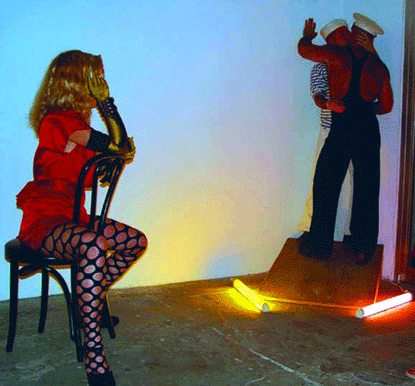Performance art stages its first Biennial in PERFORMA 05
Performance art can be a hard sell. Unlike sculpture, painting, video, or photography, performance is fluid and impermanent; it is difficult to collect and therefore difficult to take seriously. Whereas ballet and Broadway theater require an attention to plot, staging, and drama, performance knows no such barriers. Thus, it requires patience and a bit of humor on the part of the viewer. At its best, performance can be seductive by its need to engage the audience and make it complicit in the action. At its worst performance can be solipsistic and ego driven with angry, weeping monologues.
PERFORMA 05, the first biennial of visual art performance in New York, makes a great case for its value and importance. Hosted by more than 20 art galleries, performance spaces, and nightclubs around the city November 3-21, the program consisted of film screenings, live performance, lectures, and exhibitions, and featured a wide range of artists, methodologies and approaches. Noted curator and historian RoseLee Goldberg, who has been a tireless booster of performance art since the ‘60s, brought together well known pioneers such as Marina Abramovic, who recreated several durational works—her own and others of historical precedent—over seven nights at the Guggenheim. Rare films showcasing the performances and lives of Jack Smith and Bas van Ader and Genesis P-Orridge picked up the indie trail where it left off decades ago. Music-based performances by Paul D. Miller aka DJ Spooky and Min Xiao-Fen rounded out the program.
A heavy queer quotient suffused PERFORMA, with many notable artists whose work deals with gender, sexuality, and identity such as Christian Holstead, Lovett/Codagnone, Jesper Just, Michelle Handelman, Derek Jackson, Ivan Monforte, Mary Coble, Vaginal Davis, Ron Athey, and Charles Atlas. Such a long list begs the question whether performance, which traditionally encompasses dance, theater, and political protest, is a more appropriate “queer” medium for expression of sexuality than, say, homoerotic photography. Anyone who’s spun on the dance floor, vogued or sashayed as his favorite harridan du jour is the confirmed star of the night. Put another way, performance for gays comes easy.
What many of the gay artists in PERFORMA 05 changed was the lackluster simplicity of the act of disguise or gender role-play or baring the body for shock value. Danish artist Jesper Just’s “True Love Is Yet To Come,” (2005), held opening night in a Greenwich Village studio, was the knockout performance on the schedule. Part video, part 3-D holographic magic show, and part pop opera, Just’s work in video and performance often comes with a tinge of nostalgia and melancholia. His past work such as “Bliss and Heaven,” (2004), shown at Perry Rubenstein gallery in Chelsea last year, played fast and loose with male gender roles, cross-generational relationships, and Hitchcockian suspense vis-à-vis “North by Northwest.” “True Love is Yet To Come” continues in the cross generational vein by making as its narrative center the taboo of an older man’s desire for the companionship of a younger man. Maybe.
An older man wearing a dark suit appeared on a dim stage, empty except for a white curtain that looked like the lining of a well-appointed coffin, whipped up like cream. He crooned in a hesitant and chalky voice lyrics from such plaintive ditties as “Unchained Melody,” “You Always Hurt The One You Love,” and “Cry Me a River.” He serenaded and furtively grabbed for a shadowy presence that joined him on stage bathed in white light—an attractive young man suited in white—a hallucination for the crooner and a transparent projection for the audience. Jest’s technical expertise was thrilling. Live action melted into projection, actual and imagined characters moved, flew, and fell into dreamscapes, real and fake time blended seamlessly.
The climax was reached in a merry-go-round chase scene in which the lover pursued his beloved, or perhaps his youthful doppelganger, whose childish laughter in the face of the catch was chillingly perverse. Longing and searching were the main action, a gallop back to the bliss of Wordsworthian adolescence or to the abject loneliness a graying patriarch feels in the flood of missed opportunities.
Throughout the 20-odd minutes, male vanity was laid bare. At times the older man seemed to cry and blubber. At other times he faltered and fell to his knees, seemingly broken and defeated in his search for love. To add insult to injury, midway through, a chorus of men with shaved heads and decked out in white suits roared back a response to his plaintive cries for companionship and romance. Palpably vulnerable, his masculine façade has crumbled. He deserves pity and understanding. Just’s performance coaxed forth a range of romantic possibilities—missed loves, future loves, no loves.
Lovett and Codagnone, the performance duo who have been working together since 1995, also took on failed romantic possibilities, with performances crafted with sadomasochistic pain and pleasure. Like Abramovic and Chris Burden, their performances often test the body’s physical limits; distinctively, their work references literary homoerotic narratives. For PERFORMA, they mined Jean Genet’s novel “Querelle,” R.W. Fassbinder’s film version, and Oscar Wilde’s poem “The Ballad of Reading Gaol” for “Each Man Kills The Thing He Loves” (2005). In a previously similar work, the duo reprised characters from the film while Jeanne Moreau intoned the morose ballad taken from Wilde’s poem. For this work, the duo’s seemingly disembodied voices recited parts of Wilde’s poem. The space consisted of a gallows with three steps on each side sits below. Above intertwined white blue neon nooses signaled the drama. Highly conceptual and minimal in comparison to Just’s work, the idea that suffering for a doomed love or passion has rarely seemed more haunting, creepy.
Michelle Handelman is a multimedia artist working with video, performance, and digital media whose work uses the feminine body as material. She has witty sensibility and a knack for the grotesque, a heady mix. If Just and Lovett and Codagnone made you feel pseudo-suicidal—as love should—Handelman provided a counterpoint and a heart balm with “The Laughing Lounge” (2005). The work is inspired by the German cult film “Kamikaze,” also by Fassbinder, in which surveillance monitors broadcast a 24-hour laughing contest, and the laughing clubs of India, where people laugh in unison for physical and spiritual healing. In a separate part of the gallery, three performers wearing mirrored dresses laughed and sang uncontrollably as they rotated on a mechanized platform. Just and Lovett and Codagnone used a cinematic, theater-based approach for their work; Handelman’s “Laughing Lounge” demanded audience participation. The invitation asked spectators to come by, relax, and laugh their sorrows away.
The quest for happiness, like the quest for love and for erotic release is illusory and fleeting. Performance art like the best theater, dance, and film, provides escape for that one moment; it suspensefully dramatizes the passage of time. If you missed PERFORMA 05, you’ll have to wait two years for the next happening. Mark your calendars now.
gaycitynews.com




































